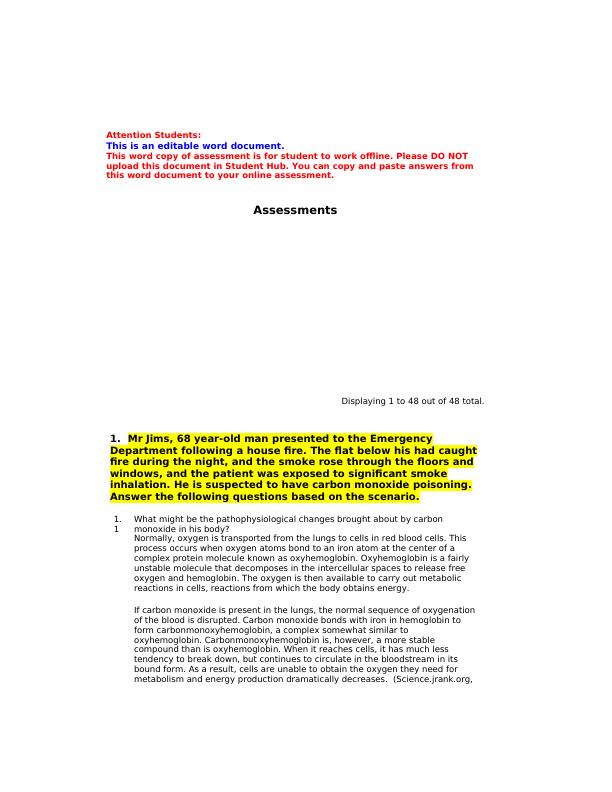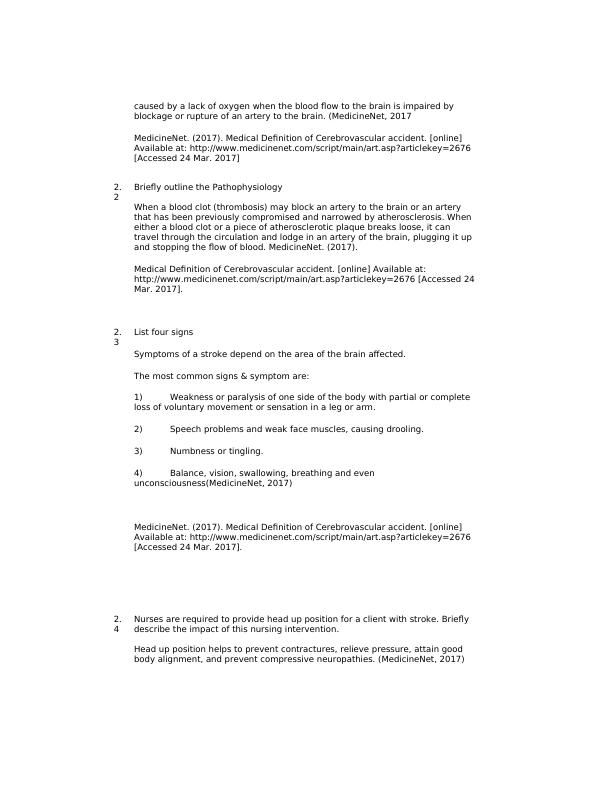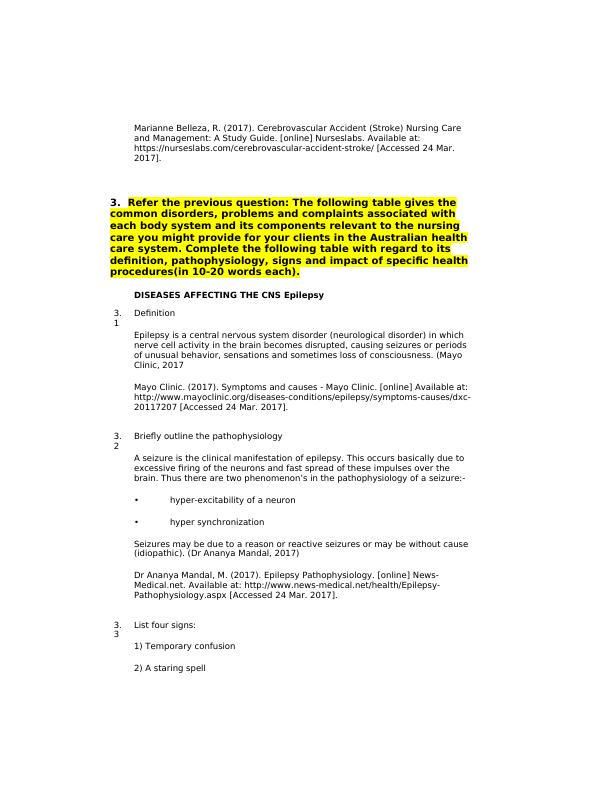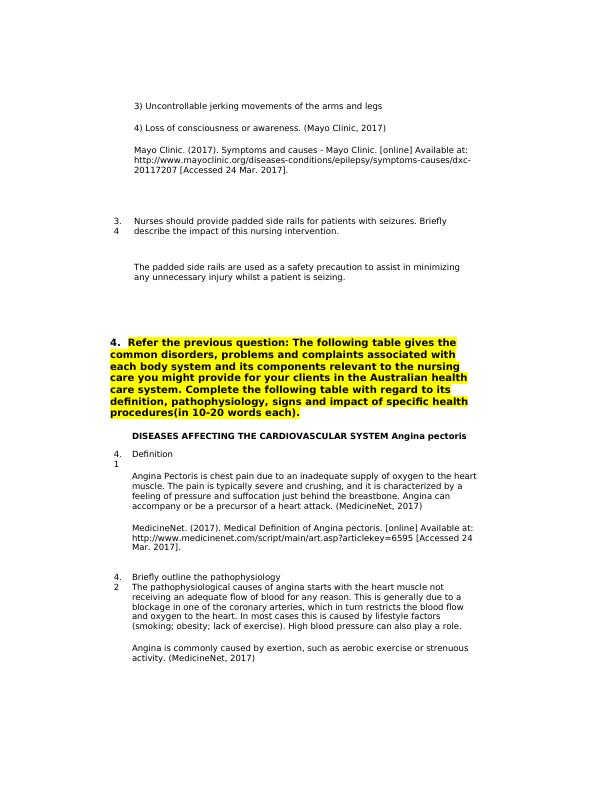Pathophysiological Changes in Carbon Monoxide Poisoning
Added on 2023-04-04
40 Pages6150 Words383 Views
Attention Students:
This is an editable word document.
This word copy of assessment is for student to work offline. Please DO NOT
upload this document in Student Hub. You can copy and paste answers from
this word document to your online assessment.
Assessments
Displaying 1 to 48 out of 48 total.
1. Mr Jims, 68 year-old man presented to the Emergency
Department following a house fire. The flat below his had caught
fire during the night, and the smoke rose through the floors and
windows, and the patient was exposed to significant smoke
inhalation. He is suspected to have carbon monoxide poisoning.
Answer the following questions based on the scenario.
1.
1
What might be the pathophysiological changes brought about by carbon
monoxide in his body?
Normally, oxygen is transported from the lungs to cells in red blood cells. This
process occurs when oxygen atoms bond to an iron atom at the center of a
complex protein molecule known as oxyhemoglobin. Oxyhemoglobin is a fairly
unstable molecule that decomposes in the intercellular spaces to release free
oxygen and hemoglobin. The oxygen is then available to carry out metabolic
reactions in cells, reactions from which the body obtains energy.
If carbon monoxide is present in the lungs, the normal sequence of oxygenation
of the blood is disrupted. Carbon monoxide bonds with iron in hemoglobin to
form carbonmonoxyhemoglobin, a complex somewhat similar to
oxyhemoglobin. Carbonmonoxyhemoglobin is, however, a more stable
compound than is oxyhemoglobin. When it reaches cells, it has much less
tendency to break down, but continues to circulate in the bloodstream in its
bound form. As a result, cells are unable to obtain the oxygen they need for
metabolism and energy production dramatically decreases. (Science.jrank.org,
This is an editable word document.
This word copy of assessment is for student to work offline. Please DO NOT
upload this document in Student Hub. You can copy and paste answers from
this word document to your online assessment.
Assessments
Displaying 1 to 48 out of 48 total.
1. Mr Jims, 68 year-old man presented to the Emergency
Department following a house fire. The flat below his had caught
fire during the night, and the smoke rose through the floors and
windows, and the patient was exposed to significant smoke
inhalation. He is suspected to have carbon monoxide poisoning.
Answer the following questions based on the scenario.
1.
1
What might be the pathophysiological changes brought about by carbon
monoxide in his body?
Normally, oxygen is transported from the lungs to cells in red blood cells. This
process occurs when oxygen atoms bond to an iron atom at the center of a
complex protein molecule known as oxyhemoglobin. Oxyhemoglobin is a fairly
unstable molecule that decomposes in the intercellular spaces to release free
oxygen and hemoglobin. The oxygen is then available to carry out metabolic
reactions in cells, reactions from which the body obtains energy.
If carbon monoxide is present in the lungs, the normal sequence of oxygenation
of the blood is disrupted. Carbon monoxide bonds with iron in hemoglobin to
form carbonmonoxyhemoglobin, a complex somewhat similar to
oxyhemoglobin. Carbonmonoxyhemoglobin is, however, a more stable
compound than is oxyhemoglobin. When it reaches cells, it has much less
tendency to break down, but continues to circulate in the bloodstream in its
bound form. As a result, cells are unable to obtain the oxygen they need for
metabolism and energy production dramatically decreases. (Science.jrank.org,

2017)
Science.jrank.org. (2017). Carbon Monoxide - Physiological Effects. [online]
Available at: http://science.jrank.org/pages/1212/Carbon-Monoxide-
Physiological-effects.html [Accessed 23 Mar. 2017].
1.
2
Enlist the seven (7) possible signs and symptoms that the patient may
manifest?
Signs and symptoms of carbon monoxide poisoning may include:
• Dull headache
• Weakness
• Dizziness
• Nausea or vomiting
• Shortness of breath
• Confusion
• Blurred vision
• Loss of consciousness (Mayo Clinic, 2017)
Mayo Clinic. (2017). Carbon monoxide poisoning Symptoms - Mayo Clinic.
[online] Available at: http://www.mayoclinic.org/diseases-conditions/carbon-
monoxide/basics/symptoms/con-20025444 [Accessed 23 Mar. 2017].
2. The following table gives the common disorders, problems
and complaints associated with each body system and its
components relevant to the nursing care you might provide for
your clients in the Australian health care system. Complete the
following table with regard to its definition, pathophysiology,
signs and impact of specific health procedures(in 10-20 words
each).
DISEASES AFFECTING THE CNS Stroke (Cerebro Vascular Accident)
2.
1
Definition
A Cerebro Vascular Accident if due to the sudden death of some brain cells
Science.jrank.org. (2017). Carbon Monoxide - Physiological Effects. [online]
Available at: http://science.jrank.org/pages/1212/Carbon-Monoxide-
Physiological-effects.html [Accessed 23 Mar. 2017].
1.
2
Enlist the seven (7) possible signs and symptoms that the patient may
manifest?
Signs and symptoms of carbon monoxide poisoning may include:
• Dull headache
• Weakness
• Dizziness
• Nausea or vomiting
• Shortness of breath
• Confusion
• Blurred vision
• Loss of consciousness (Mayo Clinic, 2017)
Mayo Clinic. (2017). Carbon monoxide poisoning Symptoms - Mayo Clinic.
[online] Available at: http://www.mayoclinic.org/diseases-conditions/carbon-
monoxide/basics/symptoms/con-20025444 [Accessed 23 Mar. 2017].
2. The following table gives the common disorders, problems
and complaints associated with each body system and its
components relevant to the nursing care you might provide for
your clients in the Australian health care system. Complete the
following table with regard to its definition, pathophysiology,
signs and impact of specific health procedures(in 10-20 words
each).
DISEASES AFFECTING THE CNS Stroke (Cerebro Vascular Accident)
2.
1
Definition
A Cerebro Vascular Accident if due to the sudden death of some brain cells

caused by a lack of oxygen when the blood flow to the brain is impaired by
blockage or rupture of an artery to the brain. (MedicineNet, 2017
MedicineNet. (2017). Medical Definition of Cerebrovascular accident. [online]
Available at: http://www.medicinenet.com/script/main/art.asp?articlekey=2676
[Accessed 24 Mar. 2017]
2.
2
Briefly outline the Pathophysiology
When a blood clot (thrombosis) may block an artery to the brain or an artery
that has been previously compromised and narrowed by atherosclerosis. When
either a blood clot or a piece of atherosclerotic plaque breaks loose, it can
travel through the circulation and lodge in an artery of the brain, plugging it up
and stopping the flow of blood. MedicineNet. (2017).
Medical Definition of Cerebrovascular accident. [online] Available at:
http://www.medicinenet.com/script/main/art.asp?articlekey=2676 [Accessed 24
Mar. 2017].
2.
3
List four signs
Symptoms of a stroke depend on the area of the brain affected.
The most common signs & symptom are:
1) Weakness or paralysis of one side of the body with partial or complete
loss of voluntary movement or sensation in a leg or arm.
2) Speech problems and weak face muscles, causing drooling.
3) Numbness or tingling.
4) Balance, vision, swallowing, breathing and even
unconsciousness(MedicineNet, 2017)
MedicineNet. (2017). Medical Definition of Cerebrovascular accident. [online]
Available at: http://www.medicinenet.com/script/main/art.asp?articlekey=2676
[Accessed 24 Mar. 2017].
2.
4
Nurses are required to provide head up position for a client with stroke. Briefly
describe the impact of this nursing intervention.
Head up position helps to prevent contractures, relieve pressure, attain good
body alignment, and prevent compressive neuropathies. (MedicineNet, 2017)
blockage or rupture of an artery to the brain. (MedicineNet, 2017
MedicineNet. (2017). Medical Definition of Cerebrovascular accident. [online]
Available at: http://www.medicinenet.com/script/main/art.asp?articlekey=2676
[Accessed 24 Mar. 2017]
2.
2
Briefly outline the Pathophysiology
When a blood clot (thrombosis) may block an artery to the brain or an artery
that has been previously compromised and narrowed by atherosclerosis. When
either a blood clot or a piece of atherosclerotic plaque breaks loose, it can
travel through the circulation and lodge in an artery of the brain, plugging it up
and stopping the flow of blood. MedicineNet. (2017).
Medical Definition of Cerebrovascular accident. [online] Available at:
http://www.medicinenet.com/script/main/art.asp?articlekey=2676 [Accessed 24
Mar. 2017].
2.
3
List four signs
Symptoms of a stroke depend on the area of the brain affected.
The most common signs & symptom are:
1) Weakness or paralysis of one side of the body with partial or complete
loss of voluntary movement or sensation in a leg or arm.
2) Speech problems and weak face muscles, causing drooling.
3) Numbness or tingling.
4) Balance, vision, swallowing, breathing and even
unconsciousness(MedicineNet, 2017)
MedicineNet. (2017). Medical Definition of Cerebrovascular accident. [online]
Available at: http://www.medicinenet.com/script/main/art.asp?articlekey=2676
[Accessed 24 Mar. 2017].
2.
4
Nurses are required to provide head up position for a client with stroke. Briefly
describe the impact of this nursing intervention.
Head up position helps to prevent contractures, relieve pressure, attain good
body alignment, and prevent compressive neuropathies. (MedicineNet, 2017)

Marianne Belleza, R. (2017). Cerebrovascular Accident (Stroke) Nursing Care
and Management: A Study Guide. [online] Nurseslabs. Available at:
https://nurseslabs.com/cerebrovascular-accident-stroke/ [Accessed 24 Mar.
2017].
3. Refer the previous question: The following table gives the
common disorders, problems and complaints associated with
each body system and its components relevant to the nursing
care you might provide for your clients in the Australian health
care system. Complete the following table with regard to its
definition, pathophysiology, signs and impact of specific health
procedures(in 10-20 words each).
DISEASES AFFECTING THE CNS Epilepsy
3.
1
Definition
Epilepsy is a central nervous system disorder (neurological disorder) in which
nerve cell activity in the brain becomes disrupted, causing seizures or periods
of unusual behavior, sensations and sometimes loss of consciousness. (Mayo
Clinic, 2017
Mayo Clinic. (2017). Symptoms and causes - Mayo Clinic. [online] Available at:
http://www.mayoclinic.org/diseases-conditions/epilepsy/symptoms-causes/dxc-
20117207 [Accessed 24 Mar. 2017].
3.
2
Briefly outline the pathophysiology
A seizure is the clinical manifestation of epilepsy. This occurs basically due to
excessive firing of the neurons and fast spread of these impulses over the
brain. Thus there are two phenomenon’s in the pathophysiology of a seizure:-
• hyper-excitability of a neuron
• hyper synchronization
Seizures may be due to a reason or reactive seizures or may be without cause
(idiopathic). (Dr Ananya Mandal, 2017)
Dr Ananya Mandal, M. (2017). Epilepsy Pathophysiology. [online] News-
Medical.net. Available at: http://www.news-medical.net/health/Epilepsy-
Pathophysiology.aspx [Accessed 24 Mar. 2017].
3.
3
List four signs:
1) Temporary confusion
2) A staring spell
and Management: A Study Guide. [online] Nurseslabs. Available at:
https://nurseslabs.com/cerebrovascular-accident-stroke/ [Accessed 24 Mar.
2017].
3. Refer the previous question: The following table gives the
common disorders, problems and complaints associated with
each body system and its components relevant to the nursing
care you might provide for your clients in the Australian health
care system. Complete the following table with regard to its
definition, pathophysiology, signs and impact of specific health
procedures(in 10-20 words each).
DISEASES AFFECTING THE CNS Epilepsy
3.
1
Definition
Epilepsy is a central nervous system disorder (neurological disorder) in which
nerve cell activity in the brain becomes disrupted, causing seizures or periods
of unusual behavior, sensations and sometimes loss of consciousness. (Mayo
Clinic, 2017
Mayo Clinic. (2017). Symptoms and causes - Mayo Clinic. [online] Available at:
http://www.mayoclinic.org/diseases-conditions/epilepsy/symptoms-causes/dxc-
20117207 [Accessed 24 Mar. 2017].
3.
2
Briefly outline the pathophysiology
A seizure is the clinical manifestation of epilepsy. This occurs basically due to
excessive firing of the neurons and fast spread of these impulses over the
brain. Thus there are two phenomenon’s in the pathophysiology of a seizure:-
• hyper-excitability of a neuron
• hyper synchronization
Seizures may be due to a reason or reactive seizures or may be without cause
(idiopathic). (Dr Ananya Mandal, 2017)
Dr Ananya Mandal, M. (2017). Epilepsy Pathophysiology. [online] News-
Medical.net. Available at: http://www.news-medical.net/health/Epilepsy-
Pathophysiology.aspx [Accessed 24 Mar. 2017].
3.
3
List four signs:
1) Temporary confusion
2) A staring spell

3) Uncontrollable jerking movements of the arms and legs
4) Loss of consciousness or awareness. (Mayo Clinic, 2017)
Mayo Clinic. (2017). Symptoms and causes - Mayo Clinic. [online] Available at:
http://www.mayoclinic.org/diseases-conditions/epilepsy/symptoms-causes/dxc-
20117207 [Accessed 24 Mar. 2017].
3.
4
Nurses should provide padded side rails for patients with seizures. Briefly
describe the impact of this nursing intervention.
The padded side rails are used as a safety precaution to assist in minimizing
any unnecessary injury whilst a patient is seizing.
4. Refer the previous question: The following table gives the
common disorders, problems and complaints associated with
each body system and its components relevant to the nursing
care you might provide for your clients in the Australian health
care system. Complete the following table with regard to its
definition, pathophysiology, signs and impact of specific health
procedures(in 10-20 words each).
DISEASES AFFECTING THE CARDIOVASCULAR SYSTEM Angina pectoris
4.
1
Definition
Angina Pectoris is chest pain due to an inadequate supply of oxygen to the heart
muscle. The pain is typically severe and crushing, and it is characterized by a
feeling of pressure and suffocation just behind the breastbone. Angina can
accompany or be a precursor of a heart attack. (MedicineNet, 2017)
MedicineNet. (2017). Medical Definition of Angina pectoris. [online] Available at:
http://www.medicinenet.com/script/main/art.asp?articlekey=6595 [Accessed 24
Mar. 2017].
4.
2
Briefly outline the pathophysiology
The pathophysiological causes of angina starts with the heart muscle not
receiving an adequate flow of blood for any reason. This is generally due to a
blockage in one of the coronary arteries, which in turn restricts the blood flow
and oxygen to the heart. In most cases this is caused by lifestyle factors
(smoking; obesity; lack of exercise). High blood pressure can also play a role.
Angina is commonly caused by exertion, such as aerobic exercise or strenuous
activity. (MedicineNet, 2017)
4) Loss of consciousness or awareness. (Mayo Clinic, 2017)
Mayo Clinic. (2017). Symptoms and causes - Mayo Clinic. [online] Available at:
http://www.mayoclinic.org/diseases-conditions/epilepsy/symptoms-causes/dxc-
20117207 [Accessed 24 Mar. 2017].
3.
4
Nurses should provide padded side rails for patients with seizures. Briefly
describe the impact of this nursing intervention.
The padded side rails are used as a safety precaution to assist in minimizing
any unnecessary injury whilst a patient is seizing.
4. Refer the previous question: The following table gives the
common disorders, problems and complaints associated with
each body system and its components relevant to the nursing
care you might provide for your clients in the Australian health
care system. Complete the following table with regard to its
definition, pathophysiology, signs and impact of specific health
procedures(in 10-20 words each).
DISEASES AFFECTING THE CARDIOVASCULAR SYSTEM Angina pectoris
4.
1
Definition
Angina Pectoris is chest pain due to an inadequate supply of oxygen to the heart
muscle. The pain is typically severe and crushing, and it is characterized by a
feeling of pressure and suffocation just behind the breastbone. Angina can
accompany or be a precursor of a heart attack. (MedicineNet, 2017)
MedicineNet. (2017). Medical Definition of Angina pectoris. [online] Available at:
http://www.medicinenet.com/script/main/art.asp?articlekey=6595 [Accessed 24
Mar. 2017].
4.
2
Briefly outline the pathophysiology
The pathophysiological causes of angina starts with the heart muscle not
receiving an adequate flow of blood for any reason. This is generally due to a
blockage in one of the coronary arteries, which in turn restricts the blood flow
and oxygen to the heart. In most cases this is caused by lifestyle factors
(smoking; obesity; lack of exercise). High blood pressure can also play a role.
Angina is commonly caused by exertion, such as aerobic exercise or strenuous
activity. (MedicineNet, 2017)

MedicineNet. (2017). Medical Definition of Angina pectoris. [online] Available at:
http://www.medicinenet.com/script/main/art.asp?articlekey=6595 [Accessed 24
Mar. 2017]
4.
3
List four specific signs
1) Retrosternal chest discomfort (pressure, heaviness, squeezing, burning,
or choking sensation)
2) Localized pain primarily in the epigastrium, back, neck, jaw, or
shoulders
3) Pain instigated by exertion, eating, exposure to cold, or emotional
stress, lasting for about 1-5 minutes and relieved by rest or nitroglycerin
4) Pain intensity not alleviated with respiration, cough, or change in
position. (MedicineNet, 2017)
MedicineNet. (2017). Medical Definition of Angina pectoris. [online] Available at:
http://www.medicinenet.com/script/main/art.asp?articlekey=6595 [Accessed 24
Mar. 2017].
4.
4
Impact of oxygen therapy in patients with angina
Oxygen therapy has been known to ease the pain associated with an acute
angina attack, only if patient is hypoxeamic. (Kones, 2011)
Kones, R. (2011). Oxygen Therapy for Acute Myocardial Infarction—Then and
Now. A Century of Uncertainty. The American Journal of Medicine, [online]
124(11), pp.1000-1005. Available at:
https://www.researchgate.net/publication/51740214_Oxygen_Therapy_for_Acute
_Myocardial_Infarction-Then_and_Now_A_Century_of_Uncertainty.
5. Refer the previous question: The following table gives the
common disorders, problems and complaints associated with
each body system and its components relevant to the nursing
care you might provide for your clients in the Australian health
care system. Complete the following table with regard to its
definition, pathophysiology, signs and impact of specific health
procedures(in 10-20 words each).
http://www.medicinenet.com/script/main/art.asp?articlekey=6595 [Accessed 24
Mar. 2017]
4.
3
List four specific signs
1) Retrosternal chest discomfort (pressure, heaviness, squeezing, burning,
or choking sensation)
2) Localized pain primarily in the epigastrium, back, neck, jaw, or
shoulders
3) Pain instigated by exertion, eating, exposure to cold, or emotional
stress, lasting for about 1-5 minutes and relieved by rest or nitroglycerin
4) Pain intensity not alleviated with respiration, cough, or change in
position. (MedicineNet, 2017)
MedicineNet. (2017). Medical Definition of Angina pectoris. [online] Available at:
http://www.medicinenet.com/script/main/art.asp?articlekey=6595 [Accessed 24
Mar. 2017].
4.
4
Impact of oxygen therapy in patients with angina
Oxygen therapy has been known to ease the pain associated with an acute
angina attack, only if patient is hypoxeamic. (Kones, 2011)
Kones, R. (2011). Oxygen Therapy for Acute Myocardial Infarction—Then and
Now. A Century of Uncertainty. The American Journal of Medicine, [online]
124(11), pp.1000-1005. Available at:
https://www.researchgate.net/publication/51740214_Oxygen_Therapy_for_Acute
_Myocardial_Infarction-Then_and_Now_A_Century_of_Uncertainty.
5. Refer the previous question: The following table gives the
common disorders, problems and complaints associated with
each body system and its components relevant to the nursing
care you might provide for your clients in the Australian health
care system. Complete the following table with regard to its
definition, pathophysiology, signs and impact of specific health
procedures(in 10-20 words each).

DISEASES AFFECTING THE CARDIOVASCULAR SYSTEM Raynaud’s
phenomenon
5.
1
Definition
5.
2
Briefly outline the pathophysiology
5.
3
List four signs
5.
4
Impact of calcium channel blockers in patients with Raynaud’s phenomenon
6. Refer the previous question: The following table gives the
common disorders, problems and complaints associated with
each body system and its components relevant to the nursing
care you might provide for your clients in the Australian health
care system. Complete the following table with regard to its
definition, pathophysiology, signs and impact of specific health
procedures(in 10-20 words each).
DISEASES AFFECTING THE RESPIRATORY SYSTEM Asthma
6.
1
Definition
phenomenon
5.
1
Definition
5.
2
Briefly outline the pathophysiology
5.
3
List four signs
5.
4
Impact of calcium channel blockers in patients with Raynaud’s phenomenon
6. Refer the previous question: The following table gives the
common disorders, problems and complaints associated with
each body system and its components relevant to the nursing
care you might provide for your clients in the Australian health
care system. Complete the following table with regard to its
definition, pathophysiology, signs and impact of specific health
procedures(in 10-20 words each).
DISEASES AFFECTING THE RESPIRATORY SYSTEM Asthma
6.
1
Definition

6.
2
Briefly outline the pathophysiology
6.
3
List four specific signs
6.
4
Impact of inhaled corticosteroids in patients with asthma
7. Refer the previous question: The following table gives the
common disorders, problems and complaints associated with
each body system and its components relevant to the nursing
care you might provide for your clients in the Australian health
care system. Complete the following table with regard to its
definition, pathophysiology, signs and impact of specific health
procedures(in 10-20 words each).
DISEASES AFFECTING THE RESPIRATORY SYSTEM Pneumonia
7.
1
Definition
7.
2
Briefly outline the pathophysiology
2
Briefly outline the pathophysiology
6.
3
List four specific signs
6.
4
Impact of inhaled corticosteroids in patients with asthma
7. Refer the previous question: The following table gives the
common disorders, problems and complaints associated with
each body system and its components relevant to the nursing
care you might provide for your clients in the Australian health
care system. Complete the following table with regard to its
definition, pathophysiology, signs and impact of specific health
procedures(in 10-20 words each).
DISEASES AFFECTING THE RESPIRATORY SYSTEM Pneumonia
7.
1
Definition
7.
2
Briefly outline the pathophysiology

End of preview
Want to access all the pages? Upload your documents or become a member.
